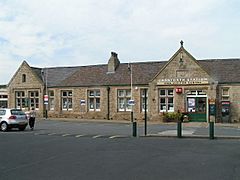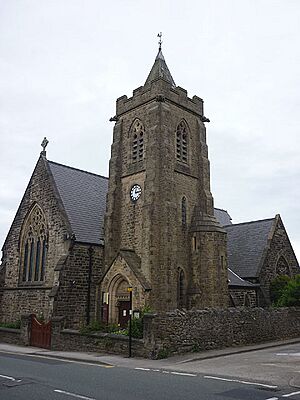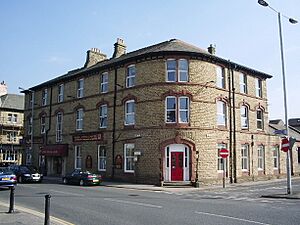Carnforth facts for kids
Quick facts for kids Carnforth |
|
|---|---|
 Carnforth station in 2005 |
|
| Population | 5,560 (2011) |
| OS grid reference | SD499704 |
| Civil parish |
|
| District | |
| Shire county | |
| Region | |
| Country | England |
| Sovereign state | United Kingdom |
| Post town | CARNFORTH |
| Postcode district | LA5 |
| Dialling code | 01524 |
| Police | Lancashire |
| Fire | Lancashire |
| Ambulance | North West |
| EU Parliament | North West England |
| UK Parliament |
|
Carnforth is a lively market town in Lancashire, England. It sits at the north-east end of Morecambe Bay. In 2011, about 5,560 people lived here.
The town is about 7 miles north of Lancaster. It is also close to the border between Cumbria and Lancashire. Carnforth grew a lot in the 1800s. This was because of its railway and ironworks. Today, it's a popular spot for walkers and cyclists. They come to explore the nearby coast and hills. The River Keer, the West Coast Main Line (a big railway), the A6 road, and the Lancaster Canal all pass through Carnforth. The M6 motorway is also very close by.
Contents
Discovering Carnforth's Past
The name Carnforth might come from its old use as a place to cross the River Keer. So, "Keer-ford" could have slowly changed into "Carnforth." Another idea is that its name comes from an old Anglo-Saxon word, "Chreneforde."
How Railways and Iron Shaped Carnforth
A big part of Carnforth's history is linked to its railway and ironworks. There was a lot of limestone nearby. Limestone is important for making iron. Because of this, the Carnforth Ironworks Company started a factory in 1846. It was built close to the railway station.
Workers from other areas, like Worcestershire, moved here for jobs. They lived in a nearby company village called Dudley, which is now known as Millhead. In 1864, the Carnforth Haematite Company took over. They made much more iron. This was possible because iron ore was brought in by train from the Furness Peninsula. By 1872, the factory tried to make steel using a new method called the Bessemer process. But this didn't work out by 1879.
Iron production continued until 1929, when the factory closed. The site was then used by the War Department as a storage place for ammunition. This lasted until the 1960s. Today, the area is an industrial estate with many different businesses.
In the 1800s, Carnforth grew from a small village into a busy railway town. This happened because it became a meeting point for three major railway lines. The Carnforth Motive Power Depot was a place where steam trains were kept and repaired. It was one of the last places in the UK to still use steam locomotives until 1968.
Today, West Coast Railways uses these buildings. They still fix and maintain steam trains there. The tall concrete tower used for loading coal onto trains is a rare sight that still stands. After 1968, the main train platforms were closed. They were removed when the railway line was made electric. However, trains still run on the Furness line and the Bentham Line.
From the 1920s to the 1980s, Morphy's Mill was a big employer for women in Carnforth. Even though it was called a "mill," it was actually a factory. It made blouses and other clothes.
Carnforth's Famous Film Connection
In 1945, Carnforth railway station became famous. It was used as a filming location for the movie Brief Encounter. This classic film starred Celia Johnson and Trevor Howard. Fans of the movie helped to get the railway station fixed up. A special refreshment room was even built to look like the one in the film. It reopened in 2021 as the Brief Encounter Refreshment Room Bistro and Bar.
You can also find exhibitions and a heritage centre there. The Carnforth Station Trust now runs these. A book called Past Encounters by local writer Deborah Swift is partly set in Carnforth during the time the film was made.
- Gallery of film locations
How Carnforth is Governed
Carnforth has its own local government area, called an electoral ward. This ward is a bit smaller than the whole parish. About 4,439 people live in this ward.
Carnforth is part of the Morecambe and Lunesdale area for national elections. Since 2024, Lizzi Collinge from the Labour Party has been the Member of Parliament for this area.
Carnforth's Location and Surroundings
The River Keer flows through the north-west part of Carnforth. It then empties into Morecambe Bay. This river forms the border between Carnforth and Warton. A bridge connects Carnforth and Millhead, allowing cars to cross the river. There is also a footbridge for people to walk across.
 |
Silverdale, Ulverston | Millhead, Kendal, Warton | Capernwray, Kirkby Lonsdale |  |
| Morecambe Bay, Barrow-in-Furness | Over Kellet, Gressingham, Pennines | |||
| Bolton-le-Sands, Hest Bank, Morecambe, Heysham | Nether Kellet, Lancaster, Galgate, Garstang, Preston | Aughton, Caton |
Getting Around Carnforth
Carnforth railway station is served by Northern Trains. You can catch trains on three different lines:
- The Bentham Line: Trains go between Leeds and Morecambe.
- The Furness line: Trains connect Manchester Airport with Barrow-in-Furness. Some trains even go further north to Carlisle.
- Morecambe Branch Line: There is one train a day to Morecambe.
Big, fast trains like those from Avanti West Coast pass through Carnforth. However, they do not stop here. To catch these trains, passengers need to go to Lancaster or Oxenholme.
Bus services in Carnforth are provided by Stagecoach Cumbria and North Lancashire and Kirkby Lonsdale Coaches. Buses connect the town to Lancaster and Morecambe in the south. They also go north to Milnthorpe, Kendal, and Keswick. The 555 bus is very popular. It goes from Lancaster to Keswick and is known for its beautiful views.
Carnforth is located on the A6 road. The M6 motorway is just to the east of the town. You can reach the motorway from Carnforth using the A601(M) and B6254 roads.
The Lancaster Canal also runs through Carnforth. There is a marina where pleasure boats can dock. In the past, the canal connected Lancaster to Kendal. Now, it is closed beyond Tewitfield, which is north of Carnforth.
Both the Lancashire Coastal Way and the Bay Cycle Way pass by the western side of Carnforth. They cross the River Keer using a footbridge.
Media and News
You can watch local TV news from BBC North West and ITV Granada. These signals come from the Lancaster TV transmitter.
Local radio stations include BBC Radio Lancashire and Heart North West. Other stations are Smooth North West, Greatest Hits Radio Lancashire, and Beyond Radio. Beyond Radio is a local community station based in Lancaster.
Carnforth has several local newspapers. These include the Lancaster Guardian, The Westmorland Gazette, and the Lancashire Evening Post.
Learning in Carnforth
Carnforth has several schools for different age groups.
Primary Schools
- Carnforth Community Primary School, on North Road
- Christ Church C of E Primary School, also on North Road
- Our Lady of Lourdes Catholic Primary School, on Kellet Road
Secondary School
- Carnforth High School
There is also a public library branch in the town.
Places of Worship
Carnforth has several churches for different faiths.
The Anglican parish church is Christ Church. It is on Lancaster Road and was built in 1875. It is a special building, listed as Grade II.
Our Lady of Lourdes Catholic church is on Kellet Road. It is a small, modern building that opened in 1967. It is part of a larger parish with other churches.
Emmanuel Congregational Church is on Hawk Street. It was started in 1884.
Carnforth Free Methodist Church began in 1995. They hold services at Carnforth High School.
The Salvation Army has a church on Preston Street. They also run a charity shop on Market Street.
The Jehovah's Witnesses have a Kingdom Hall just outside Carnforth, at Mill Lane, Warton.
Sports in Carnforth
Carnforth is home to several sports clubs. These include:
- Carnforth RUFC, a rugby union club
- Carnforth Rangers, an football club
- Carnforth Cricket Club
Famous People from Carnforth
- Cecil Parkinson (1931–2016): A well-known politician from the Conservative Party. He was born in Carnforth.
- Robert Wilson (1879–1916): A professional rugby league player.
- Steve Kemp (born 1978): A musician who attended Carnforth High School. He is known for being the drummer in the band Embrace.
- Adam Thistlethwaite (born 1988): A musician from Carnforth. He is a member of the band Massive Wagons.
Images for kids
See also
 In Spanish: Carnforth para niños
In Spanish: Carnforth para niños








